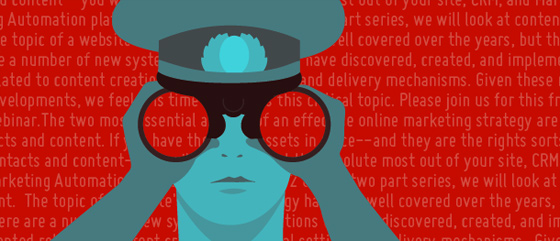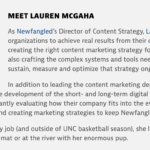Newsletters
If you are just beginning your content strategy, newsletters are probably the best way to start. As far as content strategy platforms go, they have it all. Writing a monthly newsletter most likely means that you will add around fifteen hundred to three thousand words of new content to your site each month over the span of two to six web pages (assuming around five hundred words per page). With a newsletter, you have an effective, easy to understand call to action, “Subscribe to Our Monthly Newsletter,” and it gets you in front of your prospects each month through the email you send out to them.
These three benefits: the search engine-indexable content, the call to action, and the long-term prospect nurturing, are the primary benefits you aim for from any content strategy platform. Monthly newsletters are also useful because people understand what they are. No one is confused about what signing up to receive an email once a month means. Blogs and webinars are more confusing in terms of the medium through which they are primarily transmitted (RSS for blogs and online web meeting software for webinars). This last point is a subtle one, but if your audience is not particularly tech savvy, it is one worth considering.
Another benefit of the monthly newsletter is that it is a reasonable commitment of time for you to make. You can write two thousand words about what you do once a month, I know you can. Alternatively, a blog has an expectation of frequency to it that can be tough to live up to if you are just starting your content strategy. If the blog (firm-wide, again) has not been updated in more than a few weeks, it can do more harm to your brand than good.
The Email Blast
One important point to bring up here is that the newsletter is more about the content you add to your site than the email blast you send out. Even if you only have two subscribers, your newsletter could play a significant part in your overall marketing effort, so do not allow initial low subscriber numbers to deter you.
Your blast should be carefully considered. Make it focused and brief. The goal of your content strategy is to bring people to your site so that you can wrap them in your experience and further engage them. As an element of your content strategy, the blast is simply a teaser, and its sole purpose is to entice people to come to your site to read your entire newsletter.
The email itself should be branded but also easily understood in plain text format. Include a clear headline that links to the newsletter on your site, a large and engaging image that does the same, a few sentences of summary description, and a link to “read more.” In addition, consider having one or two calls to action in the sidebar, but that should be it. Make it clear and concise, and bring people to your site.
I do not believe it matters what type of software you choose. There are many services out there that work fine for this kind of job. I have shopped around a good bit, though, and I do recommend CampaignMonitor.com as an email delivery tool. The pricing model makes perfect sense, it is reliable, and the analytics it provides are top-notch.
One last point to keep in mind about email newsletters is that they provide a great deal of value, even if the recipients do not read them all the time—or even most of the time. Again, the content that goes on your site as a result of the newsletter is visible to search engines and to anyone who visits your site forevermore, and that is an indisputable benefit. However, the email you send out is a subtle reminder to your entire audience that you are still around, you are smart, you exist just to serve them (if you are specialized), and that you are thinking and writing about topics that are relevant to them— possibly even topics which they know their current agency is not knowledgeable about. They can glean all of this in the few seconds it takes them to see your newsletter in their inbox, scan it quickly, and archive it. This brief impression is invaluable, and I encourage you to do all you can to make sure as many of your prospects as possible receive the benefit of this impression.
Blogging
If you are in the habit of creating monthly newsletters and your firm is ready to expand its content strategy, blogging is a natural next step. Blogging makes sense especially for firms that have multiple contributors. If you decide to add a blog to your site, you should commit to adding at least two to four posts to your site each month. Again, if multiple people contribute, this should not be a problem. Some firms map out each month with editorial calendars. This can be a useful tool to keep everyone aware of what is going on around them, and they can compose each post with an understanding of the greater editorial context of the content strategy. Editorial calendars are also a good way to keep people accountable and motivated.
The worst thing that can happen with your corporate blog is for it to go dark a few months after you launch it. There are far too many agency blogs online today that have not been updated in over a month. Do not launch a blog unless you know you can sustain a consistent pace. Some agencies try to get around this by not dating their posts. This only works if no one is paying attention to your blog, and if that is the case, what is the point anyway?
Having a blog is not mandatory. In fact, most agencies cannot commit to creating new and meaningful posts each week and, therefore, should not have a blog. I bring this up because I know that many agencies feel pressure to have a blog, so they start one, and then it peters out. In cases like these, it would be much better to have never started at all. A good way to test your firm’s blogging stamina is to create a blog, but keep it unpublished so that only people inside the firm can see it. If, after three months, you keep up a healthy pace of blogging, you will know that you have a good thing going, and you can release the blog with a significant amount of momentum due to the past three months of articles you’re about to release to your audience and Google.
Distributing Your Blog
The way in which people can access your blog is an interesting topic. Blogs were originally intended to be accessed via RSS (Really Simple Syndication). RSS is a handy piece of technology that allows you to sign up to feeds from the sites you frequent through an RSS reader, such as Google Reader. The idea is that instead of reading a newspaper each morning or going to ten different websites for all the different posts that may interest you, you can instead just go to your RSS reader and let the articles come to you. This makes great sense on paper, and Google Reader is one of Google’s most useful applications. However, RSS has not caught on with the mainstream, and if it were going to, I think it would have by now. RSS is still a great vehicle for information delivery and is used by other applications that you might use, but chances are that most of your prospects will not read your blog through an RSS feed.
Does that mean you do not need an RSS feed of your blog? No, it does not. Your blog should definitely have its own RSS feed. The real question is, if people do not access your blog through RSS, how do they access it? If you are lucky, some might be mindful enough to visit your site regularly to keep up with your blog, but I would not count on that.
I suggest adding an email-based call to action for your blog post. Allowing people to receive a weekly, bi-monthly, or monthly summary of your blog in their inbox gives you all the email marketing benefits mentioned in the newsletter section and offers non-RSS users a way of conveniently receiving your content on a regular basis. The frequency of the email depends on how often you blog. Each email should have at least two to three new posts in it.
Webinars
It is important to get your message to your prospects through a variety of media so that they can choose how they would like to receive it. While webinars will do little to attract new people to your
site since their SEO impact is minimal, they are an effective way to make your firm’s expertise more diversely accessible. Because of the SEO limitation, I do not recommend using webinars as the first element of your content strategy. It makes more sense to start with newsletters or blogs. If you already do one or both of those things, it is not a stretch to repurpose some of that content into webinars.
A good rule of thumb is to plan your webinars to be about thirty minutes in length, followed by up to fifteen minutes for answering any questions from the audience. I find that noon eastern standard time is a good time to broadcast the live webinar. This way, people as far west as Vancouver and as far east as Italy can join at a reasonable hour. Webinars tend to attract a diverse audience, so the time element can be key.
Webinars may seem quite daunting, but there are two tools that make them relatively easy to pull off once you have the material together: GoToWebinar(.com) and Apple’s Keynote product.
GoToWebinar is an amazingly feature-rich, affordable, and reliable tool. At the time of this writing, it costs a few hundred dollars per month. With that, you also get unlimited use of their other product, GoToMeeting (which happens to be my web meeting software of choice).
After finding the webinar information on your site, visitors can click on a link and sign up right through the GoToWebinar interface, which is quite simple. After they sign up, you can arrange for them to redirect to a page on your site. GoToWebinar sends out reminders to all registrants a few days before the webinar. For the event itself, it manages the audio, the streaming video from your desktop, a Q&A forum, and chat. Once the webinar is done, it provides you with a report of who attended, who did not, a recording of the presentation, and what the interest level was for each attendee. The tool also lets you customize follow-up emails for both those who attended and those who did not. This is a great way to sneak another call to action in to both parties.
This is a great system, and it makes webinars a valuable element of our content strategy. Even if a person does not end up attending the webinar, they have four different impressions of the firm:
1. They found the webinar initially and thought the topic was compelling enough to sign up for it.
2. They received the reminder email a few days prior to the event. 3. They received the no-guilt follow up email that was packed with
calls to action.
They are now on your webinar list, so they will hopefully hear from you each time you announce a new webinar.
As far as points of engagement go, this is about as rich as it gets. GoToWebinar can also record the webinar’s audio and video. At the end of the presentation, it automatically crunches the webinar into a reasonably-sized WMV file, which we always post to our site within a few hours of the live event. This makes every webinar an effective initial and ongoing conversion point.
The other tool that I believe is essential for webinars is Keynote. I do not know how Apple defeated Microsoft in creating the absolute best office tools (Pages, Numbers, etc.), but they did. Keynote is part of iWork, and its benefits far exceed those of Power Point. Although it takes a little bit of work to gain a full understanding of the program, becoming comfortable with Keynote is worth the time investment for both webinars and public speaking engagements.
This post is an excerpt from my book, “A Website That Works.”
#macro:blognav,24164,24169#


